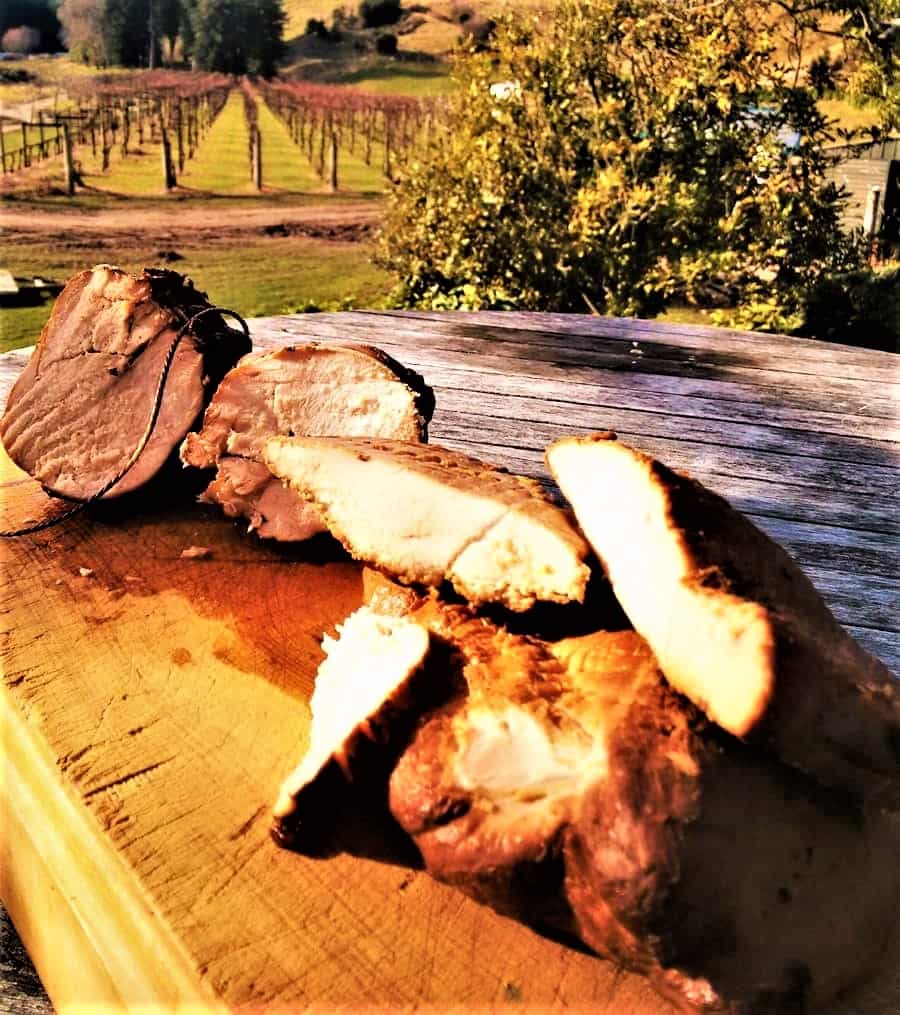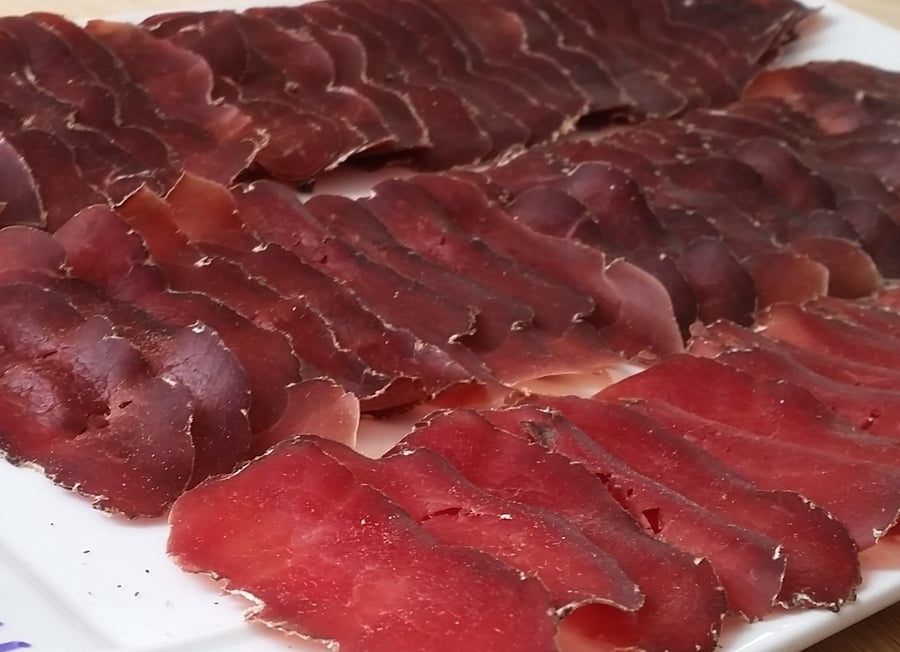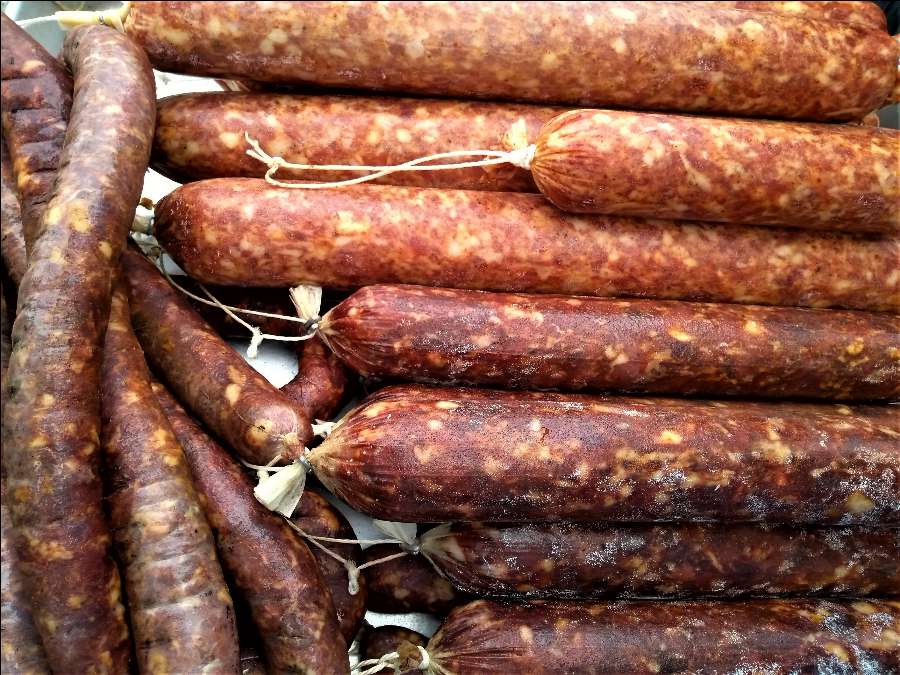When many people hear “cured meats,” they first associate the term with pork and smoked. Classics like prosciutto, pancetta, and salami are all made from pork. But if you’re avoiding pork or want to expand your charcuterie selection, there’s a whole world of non-pork cured meats to explore.
After making cured meats at home for years, I’ve discovered that non-pork options can be just as flavorful, if not more interesting.
From lean cured beef like bresaola to duck-based salamis, there are plenty of ready-to-eat or cooked cured meats that offer variety and intensity without relying on pork.
Why I Love Cured Meats That Aren’t Pork
I’ve personally dry-cured venison after hunting trips, made duck prosciutto at home, and used venison bresaola as a centerpiece for grazing platters. These meats tend to be leaner, more intense in flavor, and often more unique in texture compared to pork-based options.
If you’re crafting a board or building out your DIY curing setup, it’s worth considering beef, duck, or game-based alternatives.
Some of them are ready-to-eat cured meats, like hot-smoked turkey or duck bacon, which require cooking before serving. Either way, they open up your options and impress guests with flavors they’re less likely to have tried.
List of Cured Meats That Are Not Pork
| Beef | Wild Game | Turkey | Duck | Lamb/Goat |
|---|---|---|---|---|
| Beef Bresaola | Venison Bresaola | Turkey Bacon | Duck Bacon | Lamb Prosciutto |
| Beef Salami | Venison Salami | Turkey Pastrami | Duck Prosciutto | Lamb Salami |
| Beef Pastrami | Wild Boar Salami | Turkey Breast Ham | Duck Salami | Goat Salami |
| Beef Jerky | Game Jerky (Tahr, etc.) | Turkey Jerky | Duck Rillettes | Mutton Biltong |
| Corned Beef | Wild Coppa-style | Smoked Turkey | Duck Confit | Lamb Bresaola |
| Beef Coppa-style | Smoked Wild Sausage | Smoked Duck Ham | Goat Bresaola |

These meats all have unique flavor profiles and can be integrated into charcuterie boards, sandwiches, or eaten as standalone snacks.
Many are also leaner than pork and have different fat structures that affect how they cure and how they should be sliced or served.
Non-Pork Cured Meats in Detail
Bresaola
Bresaola is one of my go-to cured meats when I want something lean, beefy (or gamey), and easy to pair with cheese and bread. Typically made from eye of round beef or game meat, such as venison, it’s salted, seasoned, and then air-dried for 2–3 months until it firms up and develops a deep burgundy color.
I’ve made bresaola using both wild deer and store-bought beef — both work wonderfully, as long as the meat is lean and appropriately trimmed. After curing and drying, I like to slice it paper-thin and serve it with a drizzle of olive oil, shaved parmesan, or even a little arugula/rocket on sourdough. It’s subtle, aromatic, and naturally low in fat.

Cured Wild Game – Venison, Elk
If you’ve ever had access to wild game — either from a hunt or a good specialty butcher — curing venison or elk is incredibly rewarding. These meats are lean and dense, with a rich and sometimes slightly gamey flavor that pairs beautifully with earthy spices like juniper, black pepper, and rosemary.
Venison bresaola is my favorite, but you can also make small whole-muscle cures or salami-style preparations with game meat. The key is slicing it thinly, especially if it’s cured longer and dried out slightly more.
Elk tends to be harder to find commercially, but the flavor is bold and unforgettable. Like with duck, the curing process helps mellow some of the gaminess and enhances the savory depth.
When preparing wild game for curing, always use lean cuts and ensure precise trimming. Overdrying can be an issue with such low-fat meat, so I prefer slightly shorter curing and drying times, unless you’re making a fermented salami with added fat. You’ll want these slices wafer-thin on the board — they’re rich, concentrated, and full of character.
Turkey Bacon
Turkey bacon is one of the more familiar pork-free cured meats on the market — it’s easy to find, relatively affordable, and often touted as a leaner, healthier alternative to pork bacon. While it’s not dry-cured and ready-to-eat like bresaola or prosciutto, it still fits into the cured meat family because it’s cured, smoked, and must be cooked before eating.
When I first began exploring alternatives to pork bacon, turkey bacon was the most readily available option. While it doesn’t have the same fat content or mouthfeel, I’ve found it works well when I want a smoky, cured meat flavor in something like a (T)BLT or even in pasta or breakfast wraps. Commercially, it’s often smoked with hickory or applewood and comes pre-sliced and vacuum-packed.
Duck Bacon
Duck bacon is something I came across much later — and once I tried it, I was hooked. Unlike turkey bacon, which is often seen as a compromise, duck bacon feels like a gourmet upgrade. It’s usually made from the farmed duck’s breast (needs the fat), offering a dense, rich meat texture with a subtle gamey undertone. The flavor holds up well to smoking and seasoning.
Duck bacon is typically cured, cold-smoked, then sliced and cooked. The leanness of the breast meat combined with its intense flavor makes it satisfying in small amounts, and it’s a standout when crisped up and served on its own or alongside cheese, fruit, or bread. While harder to find in stores, it’s worth sourcing from specialty butchers or trying to make at home.
Duck Prosciutto
This is one of the first non-pork whole muscle cuts I ever made at home — and it’s still one of my favorites. Duck prosciutto is essentially a cured duck breast (usually from a Moulard duck), dry-cured with salt, sometimes sugar, and spices, then hung to dry for 1 to 3 weeks depending on thickness and conditions.
It’s not smoked, just salted and dried.
For a deeper look at dry curing duck and non-pork meats, this guide to duck prosciutto and non-pork charcuterie basics on Serious Eats.
The result is a firm, rich, slightly gamey meat that slices beautifully and looks visually striking on a charcuterie board. Unlike traditional pork prosciutto, duck prosciutto has a darker color and a more concentrated flavor. The fat cap, if left on during curing, becomes incredibly tender and flavorful — something I highly recommend if you want to maximize taste.
Duck prosciutto doesn’t require cooking and is ready to eat once it has been cured and dried. It pairs exceptionally well with pickled elements (like cornichons or caperberries), aged cheese, or even a drizzle of fig or balsamic glaze. Making it at home is surprisingly simple if you have a curing chamber or even a wine fridge with decent airflow and humidity control.
It’s a great entry point into the world of dry curing for those seeking a unique, pork-free alternative that remains traditional and indulgent.
Duck Salami
Duck salami is a less common but highly rewarding cured meat that delivers rich flavor and a slightly sweet, nutty depth thanks to the duck fat. Unlike whole muscle cures like duck prosciutto, salami involves a mix of finely ground meat and fat, typically fermented, then slowly dried over weeks or months.
Most duck salamis utilize a ratio of duck breast and duck fat, often combined with wine, garlic, black pepper, and occasionally juniper or cloves. The final product is firm, sliceable, and makes for a unique charcuterie board option.
It’s also a great example of how non-pork salamis can rival their pork-based cousins in complexity and satisfaction.
Duck salami is usually a deeper red with visible flecks of fat throughout. I’ve enjoyed versions that were lightly smoked, as well as others that were purely air-dried. Both bring a level of refinement that surprises people who haven’t tried duck in cured form before. It’s not always easy to find, but if you spot it at a specialty deli or farmer’s market, it’s worth picking up.
Beef Salami

Beef salami is one of the most accessible non-pork cured meats, available in many supermarkets, delis, and artisanal shops around the world. While pork salami still dominates, beef-based options are gaining popularity — especially among people avoiding pork for cultural or dietary reasons.
I’ve seen many mainstream salami being both pork and beef.
At its core, beef salami is made with ground beef and beef fat, seasoned with a mix of garlic, pepper, wine, and curing salts. It’s then fermented and dried until firm and shelf-stable.
Keep an eye out for regionally inspired versions, too. Some incorporate Middle Eastern or North African spice profiles — think cumin, coriander, or sumac — giving you even more variety from a simple beef salami base.
Great Alternatives if You Can’t Find These
If you’re struggling to find some of these meats locally, there are a few workarounds that can still help you build an excellent pork-free cured meat selection.
Smoked or dried poultry like goose or turkey is less common but occasionally available at farmer’s markets or game-focused butchers.
Lamb-based salamis are also growing in popularity. They bring their own unique richness and pair wonderfully with bold spices like harissa, paprika, or fennel. If you’re exploring homemade options, lamb is worth considering — just keep in mind the stronger flavor profile.
Related Content
Interested in learning more about salami types and cured meat styles? This article on the difference between salami and salumi breaks down the terminology and traditions.
For those who want to start making their own non-pork cured meats at home, check out the gear covered in this equipment guide for meat curing. It includes tips for controlling temperature, airflow, and humidity.
If you’re looking for inspiration and variety, here are 50 examples of cured meats and charcuterie from around the world — including many that go beyond pork.
FAQ
Do I need a smoker to make bacon?
Not necessarily. You can make delicious bacon using liquid smoke and your fridge for curing and drying. While a smoker gives the best results, it’s not essential for basic projects.
What’s the difference between cold smoked and hot smoked bacon?
Cold smoked bacon is not cooked, just smoked and dried. Hot smoked bacon is cooked during the smoking process and ready to eat immediately.
How long should I smoke bacon for?
It depends on the method. Cold smoking is usually done over multiple sessions totaling 12–24 hours. Hot smoking can take 2–4 hours depending on thickness and smoker temperature.
Can I cold smoke bacon safely at home?
Yes, with proper curing, temperature control, and good airflow. Always cure meat properly and keep it below 30°C (86°F) while smoking.
If you’re building a charcuterie board or exploring home curing, these options expand your flavor palette and suit a variety of dietary needs. Best of all, many of them are easy to make with just a bit of guidance and the right conditions.
Have any favorite non-pork cured meats or projects you’ve tried? Share your thoughts or ask a question below — I’d love to hear what you’re curing or slicing!

Tom Mueller
For decades, immersed in studying, working, learning, and teaching the craft of meat curing, sharing the passion and showcasing the world of charcuterie and smoked meat. Read More

Wild Boar is PORK!!! WTF???
Yes, I’ve raised pigs (more fat) and hunted wild pig/boar – because one is foraging the other is fed standard types of food all its like. They taste completely different and fat is completely different. Same for wild venison (deer) vs farmed vension or wild duck vs farmed duck.